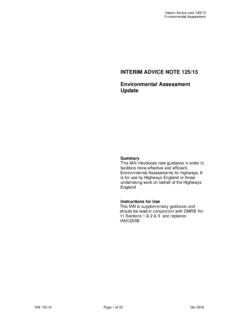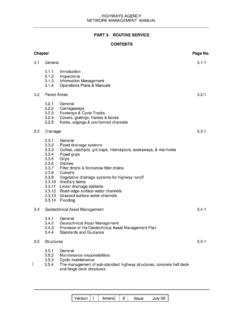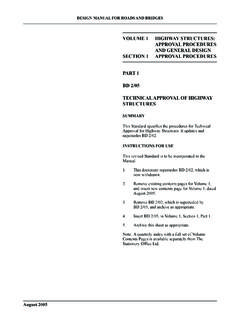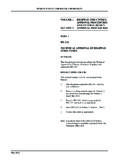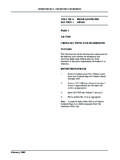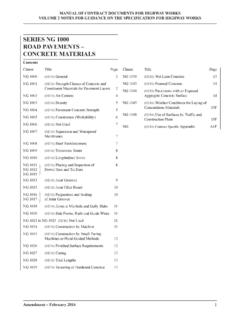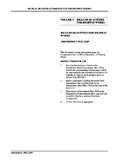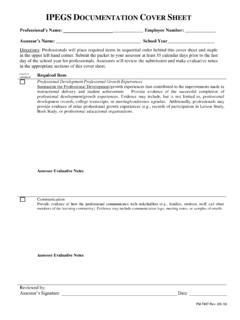Transcription of HA 74/07 - Standards for Highways
1 DESIGN MANUAL FOR ROADS AND BRIDGES. VOLUME 4 GEOTECHNICS AND. DRAINAGE. SECTION 1 EARTHWORKS. PART 6. HA 74/07 . TREATMENT OF fill AND capping . MATERIALS using either LIME OR. CEMENT OR BOTH. SUMMARY. This Advice Note provides guidance on the use of lime and cement to stabilise capping materials for highway works and slope repairs. The guidance covers site investigation, design and construction INSTRUCTIONS FOR USE. 1. This document supersedes HA 74/00, which is now withdrawn. 2. Remove HA 74/00, which is superseded by HA 74/07 and archive as appropriate. 3. Insert HA 74/07 in Volume 4, Section 1, Part 6. 4. Please archive this sheet as appropriate. Note: A quarterly index with a full set of Volume Contents Pages is available separately from The Stationery Office Ltd.
2 May 2007. DESIGN MANUAL FOR ROADS AND BRIDGES HA 74/07 . Volume 4, Section 1, Part 6. THE Highways AGENCY. TRANSPORT SCOTLAND. WELSH ASSEMBLY GOVERNMENT. LLYWODRAETH CYNULLIAD CYMRU. THE DEPARTMENT FOR REGIONAL DEVELOPMENT. NORTHERN IRELAND. Treatment of fill and capping Materials using either Lime or Cement or Both Summary: This Advice Note provides guidance on the use of lime and cement to stabilise capping materials for highway works and slope repairs. The guidance covers site investigation, design and construction Volume 4 Section 1. Part 6 HA 74/07 Registration of Amendments REGISTRATION OF AMENDMENTS. Amend Page No Signature & Date of Amend Page No Signature & Date of No incorporation of No incorporation of amendments amendments May 2007.
3 Volume 4 Section 1. Registration of Amendments Part 6 HA 74/07 . REGISTRATION OF AMENDMENTS. Amend Page No Signature & Date of Amend Page No Signature & Date of No incorporation of No incorporation of amendments amendments May 2007. DESIGN MANUAL FOR ROADS AND BRIDGES. VOLUME 4 GEOTECHNICS AND. DRAINAGE. SECTION 1 EARTHWORKS. PART 6. HA 74/07 . TREATMENT OF fill AND capping . MATERIALS using either LIME OR. CEMENT OR BOTH. Contents Chapter 1. Introduction 2. Applications and Fundamentals 3. capping 4. General fill 5. Slope Repairs 6. Environmental Considerations 7. Health and Safety Aspects of the Use of Lime and Cement 8. References 9. Enquiries Appendix A Field Identification of Common Sulfide and Sulfate Minerals Appendix B Occurrence of Sulfide and Sulfate Materials Appendix C Laboratory Identification of Common Sulfide and Sulfate Materials Appendix D Suggested Specification for Lime Treated Clay Slope Repairs Appendix E Soil Stabilisation Checklist May 2007.
4 Volume 4 Section 1 Chapter 1. Part 6 HA 74/07 Introduction 1. INTRODUCTION. General on-site monitoring is included to assist site staff in understanding the process and to provide information This Advice Note provides guidance on the use on site queries. of either lime or cement or both to treat materials. It considers aspects of investigation, design and The guidance given is applicable to roads and construction for capping , general fill and slope repairs. motorways within the jurisdiction of the Overseeing Organisation and may also be considered good practice The use of lime or cement to form capping is on other earthworks projects. given in the Specification for Highway Works (MCHW 1).
5 General guidance is provided in the Notes This Advice Note covers the specific design for Guidance on the Specification for Highway Works aspects of capping materials and general fill treated (MCHW 2). This Advice Note contains more detailed with either lime or cement or both in order to improve information and guidance on stabilised capping , their engineering characteristics. improved materials for general fills and slope repairs. The investigation, design and construction of The economic and environmental advantages of slope repairs using stabilised materials are included in the use of lime and cement have led to its successful the Advice Note. Although the quantities of material are use on a number of civil engineering projects and this smaller than for general fill and capping , the advantages Advice Note includes this experience as well as are similar and the application more readily appropriate knowledge gained from the few cases where problems given the need for efficient maintenance methods.
6 Have arisen. Site control and methods of working are described in order to facilitate the use of the method in Scope locations where economic and environmental advantages can be achieved. This Advice Note is issued for guidance on the design of capping , the improvement in general fills and Definitions and Abbreviations for slope repair design. It therefore covers projects requiring specialist plant for spreading and mixing lime Site investigation (SI) encompasses preliminary and cement with large volumes of material to much smaller projects where lime and cement may be spread sources study, planning and supervision of the ground by hand from bags and mixed with agricultural ploughs investigation contract and interpretation of factual data or conventional construction plant.
7 It advises on the site for design of a project. investigation requirements for lime or cement Ground investigation (GI) is the examination of a improvement, to complement existing MCHW and site required to provide geotechnical data which are DMRB documents. Guidance is given on ground representative of the ground conditions and relevant to investigation strategy and testing to enable designers the project considered. This includes surface and and contractors to consider lime or cement subsurface investigation, laboratory work and factual improvement as an option for new and maintenance reporting. works. Improvement is the spreading of lime on a layer Ground granulated blastfurnace slag (GGBS) and of deposited or intact granular or cohesive material , and Pulverised Fel Ash (PFA), are discussed in the Advice the subsequent process of mixing followed by Note to encourage their further consideration.
8 There is appropriate compaction to form the whole or a increasing use of these materials which needs to be constituent layer of a capping or general fill . considered on a project-specific basis. Improvement is a means of rendering unacceptable materials U1A acceptable. Attention is given to the specification of the works and testing methods for compliance of This Advice Note considers the chemical and earthworks materials. The experience gained from physical effects improvement may have on cohesive May 2007 1/1. Chapter 1 Volume 4 Section 1. Introduction Part 6 HA 74/07 . and granular soil. These effects are realised in a shorter Implementation time period, when compared to stabilisation and generally require less lime.
9 This Advice Note should be used forthwith for all projects currently being prepared provided that, in the In MCHW 1, sub-Clause , lime and opinion of the Overseeing Organisation, this would not cement stabilisation is defined as a construction result in significant additional expense or delay. The process: Designer should confirm its application to particular projects with the Overseeing Organisation. Stabilisation shall mean the spreading of either cement or lime or both on a layer of deposited or intact granular or cohesive material , and the Mutual Recognition Clause subsequent process of pulverising and mixing followed by appropriate compaction to form the It is intended that the processes and procedures in whole or a constituent layer of a capping .
10 ' this Advice Note are procured through contracts incorporating the Specification of Highway Works, This Advice Note uses this definition in terms of Clauses 104 and 105. Any contract not containing these lime or cement stabilisation of on-site cohesive and Clauses must contain a suitable clause of mutual granular material for capping . It also considers the recognition having the same effect. chemical and geotechnical effects stabilisation may have on cohesive and granular soil. These effects are realised in a longer time period where lime only is used, and generally require a greater amount of lime, when compared to lime improvement. Improvement involves the almost immediate chemical and physical effects lime has on cohesive and granular materials.
